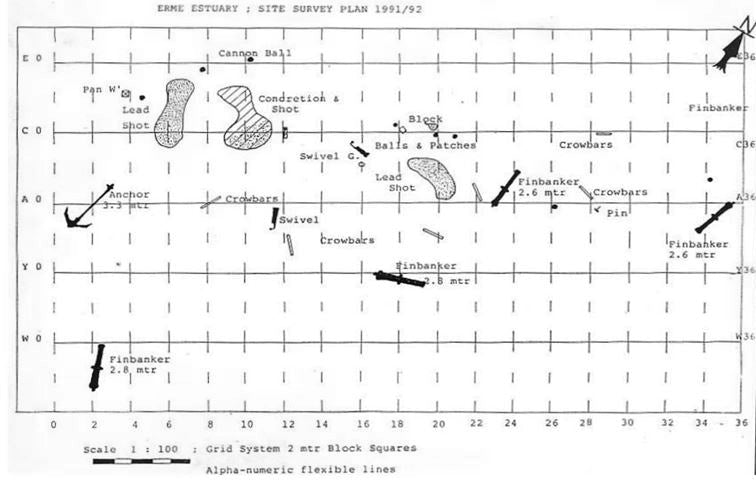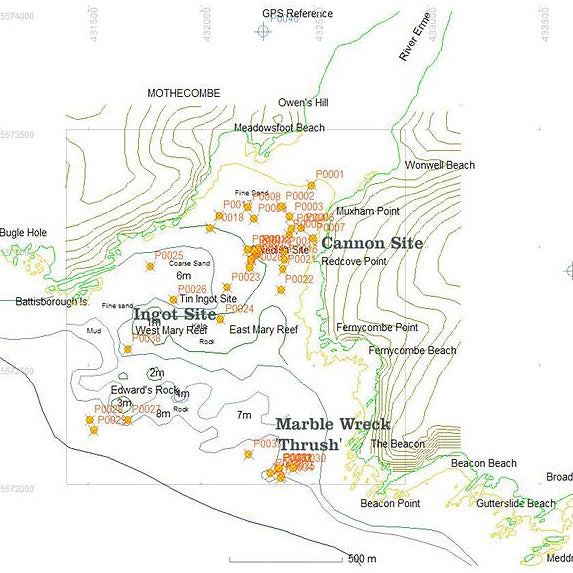Shipwrecks off the coast
September 26, 2019

The river Erme in South Devon is tidal up to 3.5 miles from its entrance where it continues upstream to its source on Dartmoor . This route takes it past some of the best archaeological remains on the moor which suggest the estuary was used for trading via the sea during the bronze age.
Over the years it has become a graveyard for ships as, from the sea, it looks like a safe place to take anchorage but the underwater 'Mary's' reef make the entrance a hazard for shipping.
The site was found by Stephen George who was snorkelling in the area in 1990 and found a swivel gun and cannon and in 1991 42 tin ingots were found in the mouth of the estuary on the north side of the West Mary Reef. Stephen was part of the Bigbury bay investigation Team who formed up with a group of divers from Northampton to form the South West Maritime Archaeological Group (SWMAG). This group did a comprehensive archaeological survey of the site in the 1990's. These ingots date from around 1000 BC confirming that tin mining / trade was a major part of the South Devon economy throughout its history. These ingots are very similar to the ones found by the SWMAG team on the Moorssands site off Salcombe. Over 13 ships have are know to have been lost in the area ranging from 1000BC to 1793. The bronze age finds suggest early bronze age ships were lost in the area.
Erme Estuary Cannon site (This is an English Heritage protected site and the current licensee is Neville Oldham)
The Erme Estuary Cannon site lies in 4-8 m of water within a 250m radius of position 50° 18.41' N, 03° 57.19' W in a partially sheltered location adjacent to West Mary's Rock at the mouth of Erme Estuary.

One of the wrecks found is thought to be a French armed merchantman. It may well have been the ship carrying Philip I of Castile and Joanna of Aragon who were rushing back to Spain to claim the throne of Castile when their fleet were wrecked in the area. The painting above give you some idea of what she may have looked like
The following sketch shows the layout of the artefacts found. One of the 'Finbanker' cannons (1630/1650 )and a swivel gun have been raised and the cannon is now on display on the quay at Hope Cove in South Devon, having been resorted and mounted on a replica carriage. The sketch below shows the layout of the site of the shipwreck.

The following magnetometer survey was carried out by Pete Holt (Sonardyne Ltd) in the 1990's ,on behalf of the South West Maritime Archaeology Group. The cluster of hits adjacent to Redcove Point are the cannon believed to be from a French ship of 1506

Known losses of ships in the area are:
|
'Mad Joanna's wreck' A fleet of 300 ships taking Phillip of Castile and his wife Joanna from Antwerp to Castile to claim his throne are caught in a storm and dispersed along the English Channel. Seven of these seek shelter at Dartmouth, some are wrecked at Melcombe and two between Dartmouth & Plymouth Two of the above fleet are lost at the mouth of the Erme and there are references to Phillip being wrecked in the Erme estuary |
January 1506 |
|
|
Unknown significant wreck |
13th January 1632 |
|
|
French Ship |
20th February 1637 |
|
|
Genoese ship |
21st February 1668 |
|
|
Dutch ship |
29th November 1691 |
|
|
French ship |
1st February 1695 |
|
|
Unidentified ship |
December 1698 |
|
|
'Rochester’ |
December 1698 |
|
|
HMS Pygmy |
15th December 1793 |
|
|
St John Baptista |
1795 |
|
|
Caroline |
December 1851 |
|
|
Commerce De paris |
1869 |
Also in News
David Scott and Pauline Ryder presented with a Highly Commended Award for services to Modbury
May 03, 2025
On Thursday 20 March David Scott and Pauline Ryder were asked to be at Follaton House, the headquarters of the South Hams District Council, for a special presentation in the afternoon.


